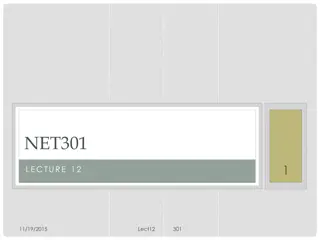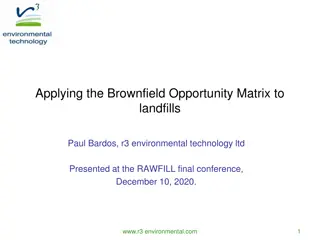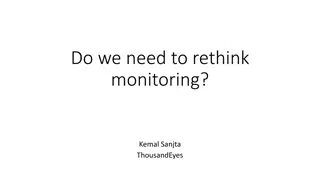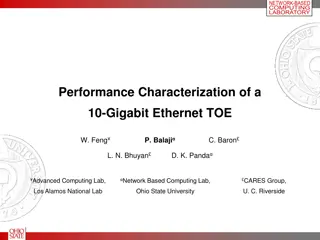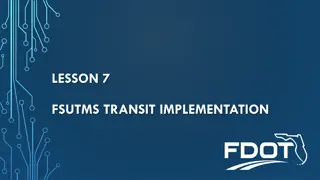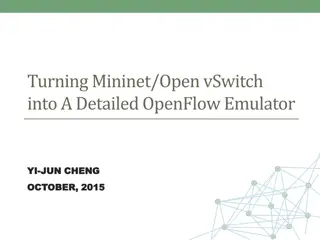Maximizing Network Performance: Tips and Considerations
Learn how to troubleshoot network performance issues effectively by understanding user expectations, tuning host specifications, optimizing PCI configurations, managing storage subsystem factors, and other critical considerations for enhancing network performance.
Uploaded on Oct 06, 2024 | 0 Views
Download Presentation

Please find below an Image/Link to download the presentation.
The content on the website is provided AS IS for your information and personal use only. It may not be sold, licensed, or shared on other websites without obtaining consent from the author. Download presentation by click this link. If you encounter any issues during the download, it is possible that the publisher has removed the file from their server.
E N D
Presentation Transcript
Performance Troubleshooting across Networks Joe Breen University of Utah Center for High Performance Computing
What are User Expectations? http://fasterdata.es.net/home/requirements-and-expectations/
What are the steps to attain the expectations? First, make sure the host specs are adequate Are you shooting for 1G, 10G, 25G, 40G, 100G? Second, tune the host most are auto-tuning but higher speeds are still problematic Third, validate network is clean between hosts Fourth, make sure the network stays clean
Host specs Motherboard specs Higher CPU speed better than higher core count PCI interrupts tie to CPU processor ==> Try to minimize crossing bus between CPU processors Storage Host Bus adapters and Network Interface Cards require the correct generation of PCI Express and the correct number of lanes
Host specs PCI bus What generation of PCI Express (PCIe) and how many lanes? 4, 8, and16 lanes possible # of lanes supported depends on motherboard and Network Interface Card (NIC) Speed of lane depends on generation of PCIe PCIe 2 -> 2.5Gb/s per lane including overhead PCIe 3 -> 5Gb/s per lane including overhead
Host specs PCI Implications PCIe v2 with 8 lanes and greater for 10G PCIe v3 with 8 lanes and greater for 40G PCIe v3 with 16 lanes and greater for 100G +
Host specs Storage subsystem factors Local disk RAID6, RAID5 or RAID 1+0 SATA or SAS Spinning disk vs SSD Network disk High speed parallel system vs NFS or SMB mounts,
Host specs and other Memory 32GB or greater Other factors such as multi-tenancy how busy is your system?
Host tuning TCP Buffers sets the max data rate Too small means TCP cannot fill the pipe Buffer size = Bandwidth * Round Trip Time Use ping for the RTT Most recent Operating Systems now have auto- tuning which helps For high bandwidth, i.e. 40Gbps+ NICs, the admin should double-check the maximum TCP buffer settings (OS dependent)
Host tuning needs info on the network Determine the Bandwidth-Delay Product (BDP) Bandwidth Delay Product = Bandwidth * Round Trip Time BDP = BW * RTT e.g. 10Gbps*70ms =700,000,000bits = 87,500,000Bytes BDP determines proper TCP Receive Window RFC 1323 allows TCP extensions, i.e. window scaling Long Fat Pipe (LFN) networks with large bandwidth delay.
Host Tuning See Notes section for links with details and description Linux # allow testing with buffers up to 128MB net.core.rmem_max = 134217728 net.core.wmem_max = 134217728 # increase Linux autotuning TCP buffer limit to 64MB net.ipv4.tcp_rmem = 4096 87380 67108864 net.ipv4.tcp_wmem = 4096 65536 67108864 # recommended default congestion control is htcp net.ipv4.tcp_congestion_control=htcp # recommended for hosts with jumbo frames enabled net.ipv4.tcp_mtu_probing=1 # recommended for CentOS7/Debian8 hosts net.core.default_qdisc = fq Modify /etc/sysctl.conf with recommended parameters Apple Mac Modify /etc/sysctl.conf with # OSX default of 3 is not big enough net.inet.tcp.win_scale_factor=8 # increase OSX TCP autotuning maximums net.inet.tcp.autorcvbufmax=33554432 net.inet.tcp.autosndbufmax=33554432 recommended parameters
Host Tuning See Notes section for links with details and description MS Windows Show the autotuning status - "netsh interface tcp show global" Use Powershell Network cmdlets for changing parameters in Windows 10 and Windows 2016 e.g. Set-NetTCPSetting -SettingName "Custom" -CongestionProvider CTCP -InitialCongestionWindowMss 6
What does the Network look like? What bandwidth do you expect? How far away is the destination? What is the round trip time that ping gives? Are you able to support jumbo frames? Send test packets with the "don't fragment bit set Linux or Mac: "ping -s 9000 -Mdo <destination>" Windows: "ping -l 9000 -f <destination>"
What does the Network look like? Do you have asymmetric routing? Traceroute from your local machine gives one direction Are you able to traceroute from the remote site? Are they mirrors of each other?
What does the Network look like? Determine the Bandwidth-Delay Product (BDP) Bandwidth Delay Product = Bandwidth * Round Trip Time BDP = BW * RTT e.g. 10Gbps*70ms =700,000,000bits = 87,500,000Bytes BDP determines proper TCP Receive Window RFC 1323 allows TCP extensions, i.e. window scaling Long Fat Pipe (LFN) networks with large bandwidth delay.
How clean does the network really have to be? http://fasterdata.es.net/network-tuning/tcp-issues-explained/packet-loss/
How do I validate the network? Measurement! Active measurement Perfsonar www.perfsonar.net Iperf - https://github.com/esnet/iperf Nuttcp - https://www.nuttcp.net/Welcome%20Page.html Passive measurement Nagios, Solarwinds, Zabbix, Zenoss Cacti, PRTG, RRDtool Trend the drops/discards
How do I make sure the network is clean on a continual basis? Design network security zone without performance inhibitors Set up appropriate full bandwidth security Access Control Lists Remotely Triggered Black Hole Routing Setup ongoing monitoring with tools such as perfSONAR Create a maddash dashboard
Set up a performance/security zone Science DMZ architecture is a dedicated performance/security zone on a campus http://fasterdata.es.net/science-dmz/motivation/
Use the right tool Rclone - https://rclone.org/ Globus - https://www.globus.org/ FDT - http://monalisa.cern.ch/FDT/ Bbcp - http://www.slac.stanford.edu/~abh/bbcp/ Udt - http://udt.sourceforge.net/
Techniques such as Packet Pacing 100G Host, Parallel Streams: no pacing vs 20G pacing Credit: Brian Tierney, Nathan Hanford, Dipak Ghosal https://www.es.net/assets/pubs_presos/packet-pacing.pdf
Techniques such as Packet Pacing Credit: Brian Tierney, Nathan Hanford, Dipak Ghosal https://www.es.net/assets/pubs_presos/packet-pacing.pdf
Not just about research Troubleshooting to the cloud is similar High latency, with big pipes Latency is not just to the front door but also internal to the cloud providers Example: Backups to the cloud are a lot like big science flows
Live example troubleshooting using bwctl on perfsonar boxes Bwctl -s <server_ip> -c <client_ip>
References: See Notes pages on print out of slides for references for each slide





